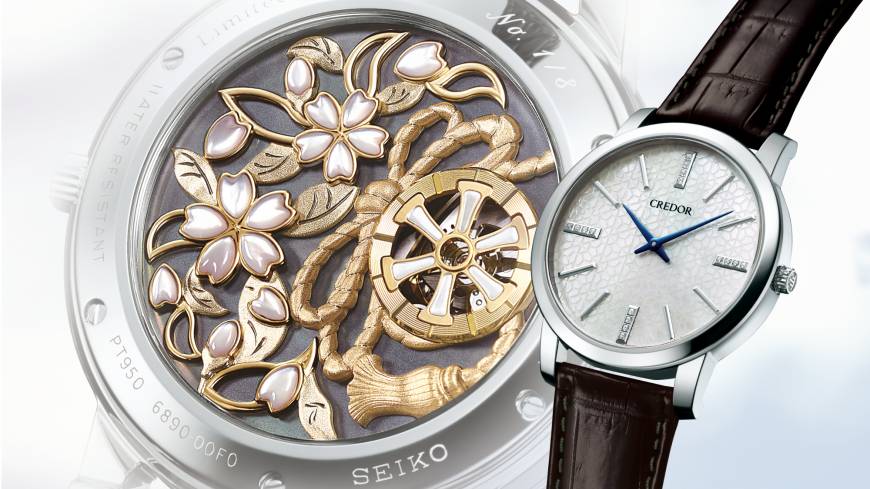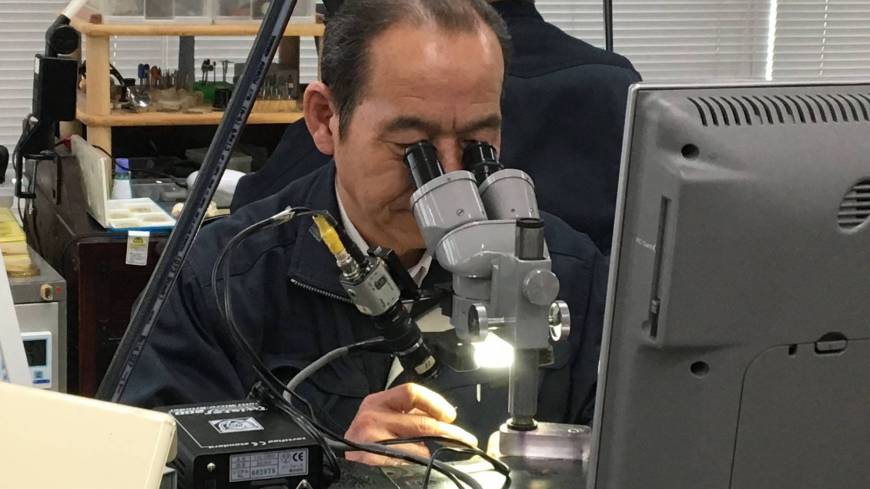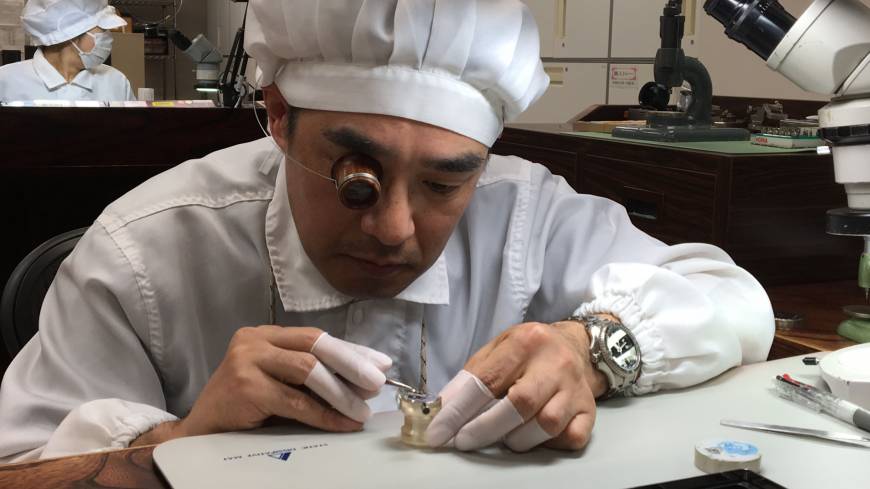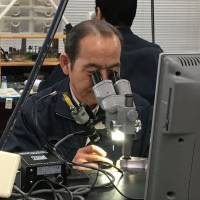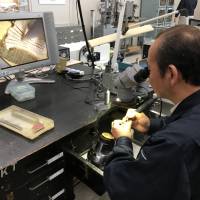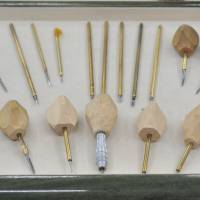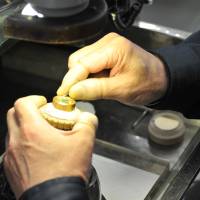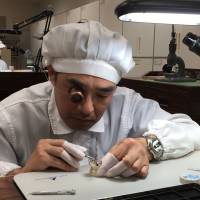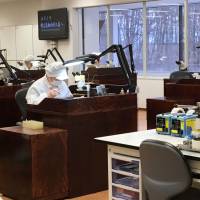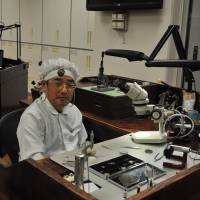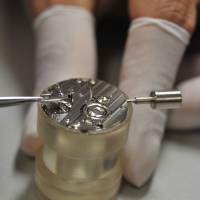Added value by engraving
The upcoming limited edition — only eight watches are being made — features 3-D engraved decorations. However, the decorative design cannot be observed from the front.
This represents the Japanese aesthetic called uramasari. Traditionally, Japanese people enjoyed the contrast between inner and outer designs, as seen in men’s haori coats — plain and simple on the outside, but lined with better quality material, and bold flashes of color and patterns. It used to be regarded as more fashionable for gentlemen to keep these inner designs invisible rather than show them off.
Embodying this spirit, the new watch has a simple yet chic face, but the case back is decorated with breathtakingly gorgeous cherry blossoms, a symbolic icon of Japan, and an oxcart, an ancient vehicle often used as a display of authority by Kyoto nobles.
And all these motifs are single-handedly engraved by Kiyoshi Terui, a contemporary master craftsman from Seiko.
“I’ve never engraved such a 3-D design before,” said Terui, who was awarded the Medal with Yellow Ribbon in 2007. In an elegant image of cherry-blossom viewing at night in ancient Kyoto, the ornate decorations are arranged with four layers of cherry blossoms and three layers of the oxcart within a space measuring just 1.75 millimeters. “It’s technically very difficult,” the master engraver said.
However, it was Terui’s eagerness to take on new challenges that produced the idea. “I wanted to make something three-dimensional this time,” he said.
When Seiko decided in the 1990s to once again produce fine mechanical watches, Terui was asked to join the project in 1995 and has contributed to giving added value to the high-end Credor series with his superb engraving technique.
“My previous experience engraving watchcases at Seiko for 20 years has helped me to develop ideas for my current duties,” said Terui, who has done all kinds of things mostly on his own to make the decoration more elaborate. Through much trial and error, he developed his original engraving method by fusing the techniques of sharp and lustrous Japanese-style carving with the soft and delicate styles of the West. He even invented original gravers to produce the sheen and sharpness without the need for polishing.
Among the technical highlights is the rope of the oxcart that is finished by hand to give a round shape to its base. Skillfully contrasting the mirror finish using his graver with a silky finish using a diamond bur, Terui creates a soft texture for the rope design.
Also, he had to carefully engrave the white mother-of-pearl shells, which is harder but more fragile than metal, into the raised shape of cherry blossom petals, and arrange the openwork cherry leaves to add depth. With all these combinations, Terui creates a rich world of beauty with unprecedented three-dimensionality.
It takes around one month to finish engraving one piece. All the work by hand is done under a microscope and extreme concentration is required as every step once completed is difficult to undo. Terui seems to juggle his mental tension with creativity.
“Although I concentrate on my hands to complete the task, of course, it may happen that new ideas just flash into my head. It’s never about simply repeating the same work every day,” said Terui with a smile. “I always think about what I want to create next.”
Assembly in Morioka
All the parts engraved by Terui for the upcoming limited edition are transported to Morioka and assembled by another master craftsman of Seiko, Katsuo Saito, who works at Shizukuishi Watch Studio.
Nestled in the forests of the Shizukuishi basin and blessed with a panoramic view of Mount Iwate, Shizukuishi Watch Studio was established in 2004 within Morioka Seiko Instruments Inc., a watch-manufacturing base since 1970 of Seiko Instruments Inc. (SII) within the Seiko group.
As part of the Seiko mechanical watch revival project, and working to overcome the aftereffects of the 2011 Great East Japan Earthquake and tsunami in the Tohoku region, the studio has served as the only site in Japan that is capable of the fully integrated production of mechanical watches, from manufacturing parts to assembling them into complete watches. Although the engravers under Terui also belong to this studio, they work at the SII headquarters in Chiba Prefecture close to the designers.
The new limited edition is loaded with the Caliber 6890 that is based on the Caliber 68, Seiko’s ultrathin movement collection. The movement is just 1.98 millimeters thick, almost the same thickness as a ¥500 coin. Because it is so thin, the component parts, including wheels, screws, springs and plates, are so small that it is impossible for computer-controlled machinery to manufacture them. Only the refined human sensitivities of each experienced craftsman can control the machines to produce the components.
When all these tiny and thin components are properly produced, it is Saito’s turn to assemble them into a movement by hand.
With his some 20 colleagues at the studio, Saito sits at a customized urushi-lacquered workbench from local manufacturer Iwayado Tansu, which has been making furniture since the 1780s, The setting is comfortable and relaxing, and it is little wonder that the craftsmen there are able to produce such high-quality work, of which they are justifiably proud.
While explaining the basic structure of a mechanical watch, Saito showed how the pinion of the escape wheel and the fourth wheel mesh with each other, and how that assembly meshes with the next wheel and so on.
“In the case of such an extremely thin movement as the Caliber 68 series, there is only 0.01 millimeters of room inside,” Saito explained. On the other hand, because of this thinness, it is inevitable that the component wheels and plates are slightly warped during their manufacture. So he uses the sensitivity of his experienced fingers to make them flat.
“This watch cannot be assembled in just one work session. If even one of the 127 assembled components does not fit with the next component, the movement won’t work,,” Saito said. “So I need to disassemble the movement, adjust each component and assemble them again.” And again and again about four or five times, he said.
Especially, the hairspring that determines the accuracy of the watch is too delicate to be adjusted by machine. Only a few master craftsmen in Japan like Saito can make the final tuning to the finest level. Saito has to work hard to adjust the balance by single microns to achieve better than a standard accuracy of -15/+25 seconds per day.
“Because I would like to have such a watch if I were a client,” Saito said with a smile.
The climax comes when he sets the balance wheel with the hairspring that controls the repetitive motions of the pallet fork. Saito holds his breath and ensures that every part is perfectly balanced. Then the movement starts as if it is alive. This is the technique that Saito has learned from his master and legendary assembler Mamoru Sakurada since the launch of the studio in 2004, and what he is passing down to the next generations.
Each owner of the limited edition watches, which are priced at ¥9.5 million, excluding tax, will be able to see the motion of the balance wheel set by Saito through the wheel of the oxcart engraved by Terui. And that may evoke a feeling of eternal time as if the cart is moving slowly under the cherry blossoms in full bloom.
This content is provided by Seiko Watch Corp.

